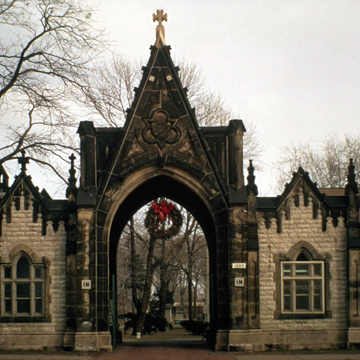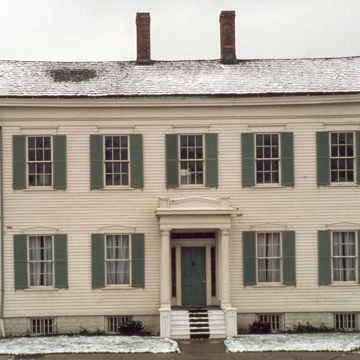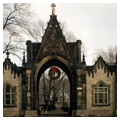In 1846 Alexander Frazer, John Owen, Charles C. Trowbridge, Henry Ledyard, Israel Coe, John S. Jenness, and other Detroiters established Elmwood Cemetery and selected a tract of some forty-two acres on the George Hunt Farm, then in Hamtramck Township, in the suburbs of Detroit. Additional acquisitions of land doubled by the early 1890s the size of the cemetery grounds. Then, in 1891, because of the need to adopt some general management principles, the cemetery's board of trustees called on Olmsted to visit Elmwood and to make suggestions. As recorded in the publication Elmwood Cemetery, Detroit (1895), Olmsted noted that Elmwood would soon be in the heart of the haste, bustle, impatience, and disquiet of a great town and that soothing natural, rural scenery would be a welcoming retreat. He recommended restoring and maintaining its original character with “umbrageous trees and screening thickets.”
Today the Protestant Elmwood Cemetery, together with two other cemeteries dating from the nineteenth century—the Catholic Mt. Elliott Cemetery and the Jewish Lafayette Street Cemetery—is encircled by an iron fence, within which mature trees, meandering roads, and formal medieval-styled gateways enhance the rural character. Detroit's east-side cemeteries are the oldest in the city (Lafayette Street Cemetery is the oldest Jewish cemetery in Michigan) and a final resting place for prominent citizens of Michigan.
The stone entrance gate that adjoins the small gable-roofed Elmwood Cemetery office, designed by Gordon W. Lloyd in 1882, has a large Gothic-arched portal. Originally designed by Albert H. Jordan in 1850–1857, the stone Gothic chapel was rebuilt after a fire. Of particular interest at Elmwood is the Caulkins memorial monument with its inlaid blue and yellow Pewabic tiles and turquoise vase. It was Mary Chase Perry Stratton's memorial to Horace J. Caulkins (1850–1923), the dental products manufacturer who was her sponsor.


















